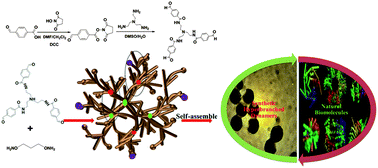Nonamphiphilic hyperbranched polyoximes (HPOXs) were successfully synthesized by the polycondensation of trialdehyde and bis-aminooxy monomers with different molar feeding ratios. Various characterization techniques, such as 1D and 2D nuclear magnetic resonance (NMR), Fourier transform infrared spectroscopy (FTIR), and multi-detector gel permeation chromatography (GPC) were used to identify the highly branched structure of the HPOXs. Despite there being no amphiphilic block segments, HPOXs with a torispherical structure could self-assemble into nanoparticles in a mixed solution of dimethyl sulfoxide and H2O. Besides, the modulation of the degree of branching (DB) and the terminal groups resulted in the appearance of spherical and bowl-shaped morphologies due to the change of the intra- and inter-molecular interactions. Accordingly, dynamic light scattering (DLS), transmission electron microscopy (TEM), atomic force microscopy (AFM), scanning electron microscopy (SEM), fluorescence spectroscopy (FL) together with ultraviolet and visible spectrometery (UV-vis) were employed to unravel the tentative mechanism of the formation of the HPOX self-assemblies. Moreover, dynamic oxime linkages and hydrogen bonds endowed the HPOX nanoparticles with pH and thermal dual responsiveness, which was confirmed by TEM measurements. HPOXs are developed to offer a novel pathway for the design of nonamphiphilic self-assemblies with dual responsiveness.

You have access to this article
 Please wait while we load your content...
Something went wrong. Try again?
Please wait while we load your content...
Something went wrong. Try again?


 Please wait while we load your content...
Please wait while we load your content...